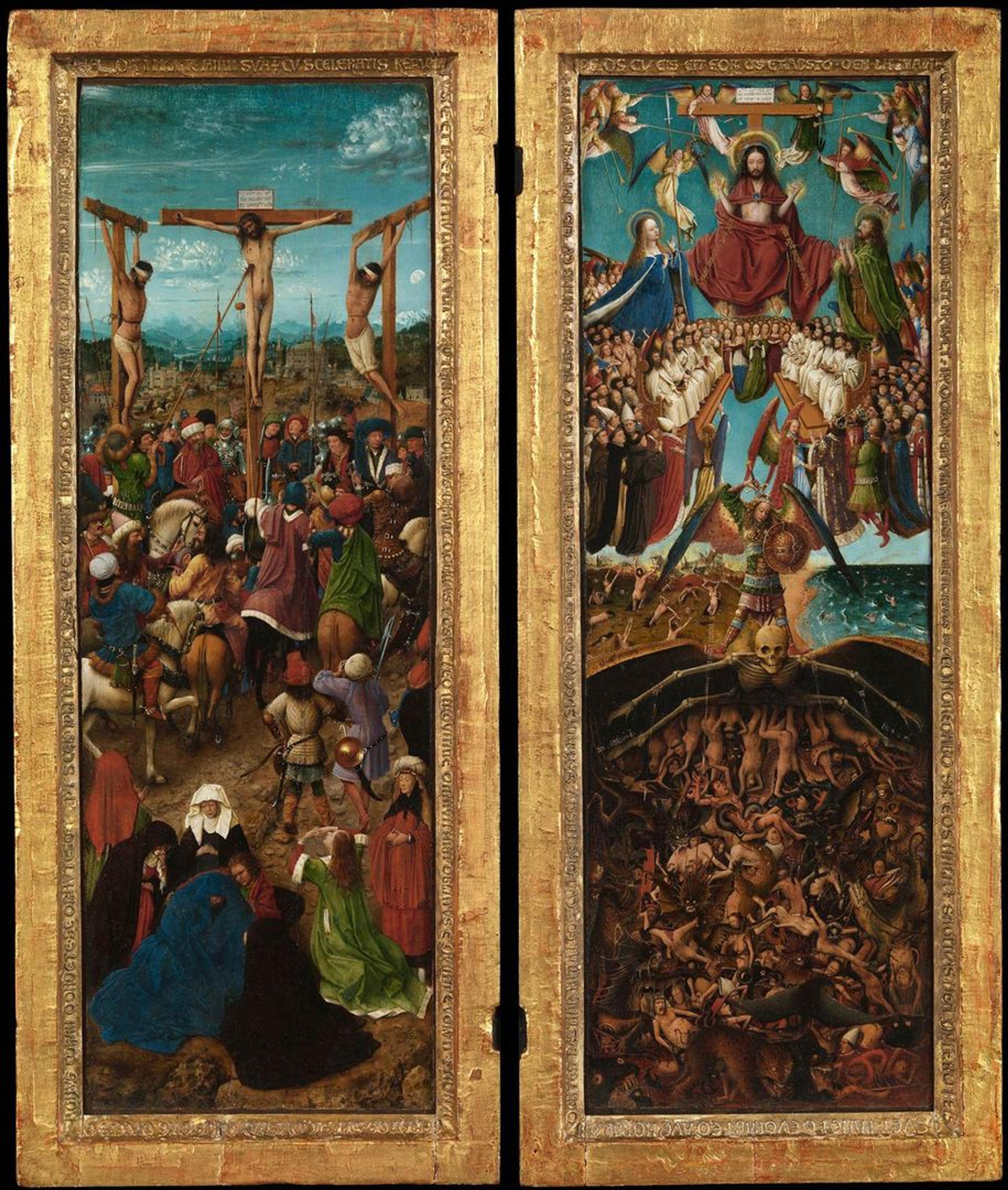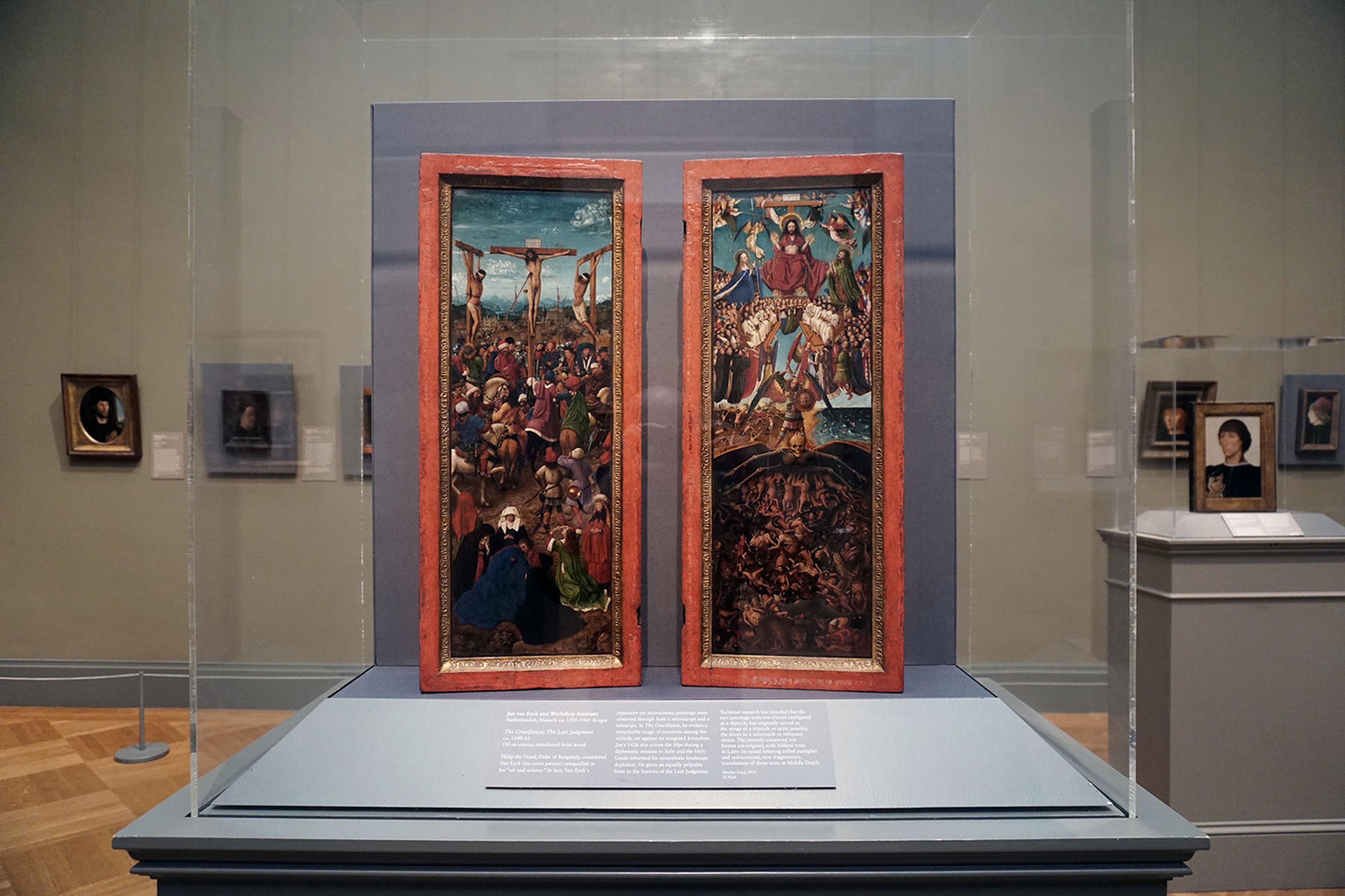Unlocking the Mysteries of Two Jan van Eyck Frames, Part Five: Mysteries Unlocked

Jan van Eyck (Netherlandish, ca. 1390–1441) and Workshop Assistant. The Crucifixion; The Last Judgment, ca. 1440–41. Oil on canvas, transferred from wood, each: 22 1/4 x 7 2/3 in. (56.5 x 19.7 cm). The Metropolitan Museum of Art, New York, Fletcher Fund, 1933 (33.92ab)
What an extraordinary detective story this has been!
We started with the unexpected discovery of a hidden text on the frames of Jan van Eyck's Crucifixion and Last Judgment, and then leveraged scientific research to help determine what was original to the paintings and what was not. The decision was made to restore the frames to their intended red color, and, finally, an ace paleographer deciphered the fragmentary Middle Dutch biblical text, which turned out to be a translation of the Latin pastiglia on the inner cove of the frames.
The result of the thrilling teamwork involved in this investigation is that, all together, we have been able to return these frames—an essential, integral part of Van Eyck's conception for the paintings—to a state that is closer to what was originally intended. Now thinking back to the modern gold-colored (brass actually!) restoration that had hidden all of this information for many decades, it is hard to even conceive of such a misconception. The red frames look so genuine and compatible with the aesthetic of the paintings that any other solution is not imaginable. Now that the paintings have been reinstalled in their frames, they are back on view in gallery 641.

The Crucifixion and Last Judgment reinstalled in their newly conserved frames in gallery 641
There is enormous satisfaction in realizing, and then being able to implement, what was envisioned by Van Eyck and the unknown individual who commissioned the work. We can now appreciate how the Crucifixion and Last Judgment served to aid the priest celebrant and various worshippers in their devotional practices. Kneeling before these exquisite and detailed depictions of the stories of the Crucifixion and Last Judgment, the viewer was encouraged simultaneously to become immersed in Van Eyck's paintings and to read the biblical texts that he so carefully coordinated to go with them.
The Latin inscriptions on the cove of the frames were in the language known to the priest, but clearly these texts needed to serve a wider audience; the Middle Dutch translation—the vernacular language of the time—was therefore added in order to allow a less learned participant to fully engage in the same devotional experience. In this way, the production of the artwork facilitated the meaning and use of the paintings in their own time.
Although there are still other ongoing investigations of these masterpieces of The Met collection—namely their patronage and the evolution of their form, likely from tabernacle doors to a diptych and to triptych wings—we have unraveled at least some of the mysteries that these works still hold. The results of our further research on these glorious paintings will appear in their online collection entry and in future publications.
The Crucifixion and The Last Judgment are on view at The Met Fifth Avenue in gallery 641.
Related Content
Explore all of the articles in this blog series.
Read a selection of essays on the Heilbrunn Timeline of Art History that discuss topics related to this article: "Early Netherlandish Painting"; "Jan van Eyck (ca. 1390–1441)"; "Painting in Oil in the Low Countries and Its Spread to Southern Europe."
What's going on in The Met's Old Master galleries? View the web feature Met Masterpieces in a New Light to learn about the European Paintings Skylights Project, in which the skylights that admit natural overhead light into the galleries for optimal viewing of the collection will be replaced, in order to update and improve the quality of light in the galleries and resolve basic maintenance issues.
Maryan Ainsworth
Curator Emerita Maryan Ainsworth received her BA and MA in Art History from Oberlin College and her PhD from Yale University. A Museum staff member since 1977, she has specialized in the technical examination of paintings, initially in the Department of Paintings Conservation and subsequently as curator in European Paintings. Her publications and exhibitions include monographic studies on Bouts, Christus, David, Gossart, and Coecke van Alest, as well as the Met's early German paintings. Maryan is an adjunct professor at Barnard College, and she has been awarded the titles of Chevalier de l'Ordre de la Couronne (2001) and Chevalier de l'Ordre de Léopold (2011), bestowed by King Albert II of Belgium.